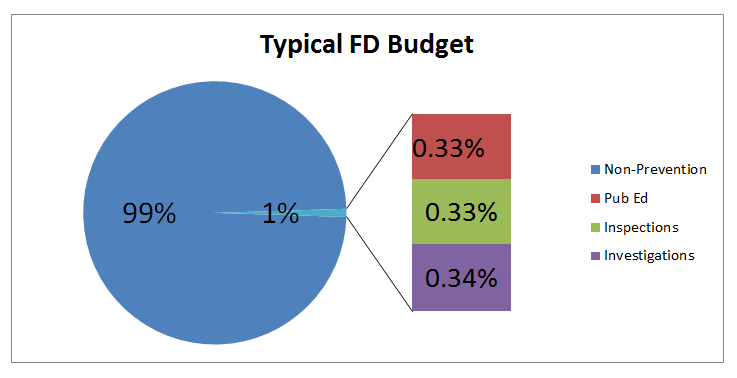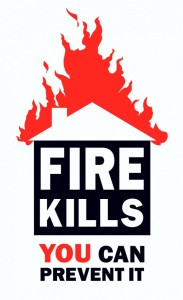By: Robert Avsec, Executive Fire Officer
Will the last person in fire prevention turn out the lights when you leave?
Fire suppression or fire prevention (There’s something to the fact I just typed those five words in that order without a thought). Ask most firefighters what their job is and the first words out of their mouths will typically be focused on “after the fact” stuff: rapid response, search, and rescue, stop a fire, etc. Ask most fire department leaders what their job is and you’ll hear things like: fire suppression, advantages of Novec 1230, fire inspections, public education, etc.
Many fire departments have “talked a good game” in the past regarding fire prevention. They included it in their new mission statements and strategic plans, shoot, many even gave new names to their fire prevention bureau or division, e.g., Fire and Life Safety Division. But follow the money and you get a much different picture.
See, in most fire departments when they talk about the fire prevention bureau or division (or whatever name they give the “non-suppression” forces) they’re talking about three quite different disciplines: public fire education, fire code enforcement inspections, and fire origin and cause investigations. In the typical fire department those three fields of fire prevention must share a fiscal “pie” that comes from 1 percent (or less) of the total departmental operating budget.

Budget cuts are forcing many departments to cut full-time staff positions (Any guesses where those first cuts take place?) and reduce services or programs (Any guesses for this one?). Declining numbers of people volunteering as firefighters in smaller communities mean similar reductions in available staffing and a department’s ability to deliver services.
Even fire departments that had “good” fire prevention programs, i.e., people and money to make them effective, are feeling the “hurt.” So, what’s happening in departments that never really “put the P” in their prevention efforts?
 In too many cases, fire prevention is being “thrown under the bus” during budget reductions. Rather than taking meaningful steps to re-engineer or reinvent what their departments can effectively accomplish with the available resources, too many fire service leaders are “clinging” to fire suppression at the expense of fire prevention.
In too many cases, fire prevention is being “thrown under the bus” during budget reductions. Rather than taking meaningful steps to re-engineer or reinvent what their departments can effectively accomplish with the available resources, too many fire service leaders are “clinging” to fire suppression at the expense of fire prevention.
And in many cases, they’re doing it with fewer people and aging equipment as they struggle to “do more with less” (one of the more infamous oxymorons of all-time in my opinion).
Putting out fires after they’ve happened is, and always has been, a losing end-game. We not only can do better, but we must also do better. Why? Because a look at the “big picture” says:
We’ll never close the ever-widening gap between the building construction industry’s ability to construct buildings with lighter, cheaper, and more volatile materials and our ability to suppress a fire before it inflicts severe damage on the structure. (They have the money, and we don’t). Do check it out to know what is the construction expert’s point of view for this case.
The Baby Boom Generation keeps getting older and living longer than any generation before theirs (The youngest boomers have already reached their 65th birthday). They are also continuing to live in residential housing further into their lifetime. Their lack of mobility and under-lying medical conditions that accompany their aging makes them an “easy mark” for a fire that can rapidly create an IDLH (Immediately Dangerous to Life and Health) atmosphere and reach a flashover state faster than ever before.
Rapid fire growth will kill the building occupants long before the first fire apparatus arrives at the scene. Check out this latest video from the National Fire Sprinkler Association’s series, The Truth about Residential Fire Sprinklers, to see just how fast today’s fires grow!
One of my former chief officers who taught me my first lessons about budgeting in the fire service gave me this sage advice:
The politicians will give you money every day of the week for equipment because those are one-time expenditures. Money for more staffing, well that’s a different story because people are forever.
Fire department leaders who believe that they will ever replace people lost to budget cuts—or acquire significant numbers of new positions—in the future are living in some parallel universe.
See Related: A New Direction for Fire Protection in the USA
Driving a car once was an extremely dangerous activity for the average person (and it still is for people that don’t give it their full attention). In the United States, we’ve made significant reductions in the mortality and morbidity statistics associated with motor vehicle crashes and we’ve done it through education, engineering, and enforcement. We’re far past the time when we need to put more of our energies and efforts into those “3-E’s”—way more! —when it comes to eliminating preventable fires in our communities.
See Related: America’s Continued “Addiction” to Fire Suppression
 Fire & EMS Leader Pro The job of old firefighters is to teach young firefighters how to become old firefighters!
Fire & EMS Leader Pro The job of old firefighters is to teach young firefighters how to become old firefighters!
